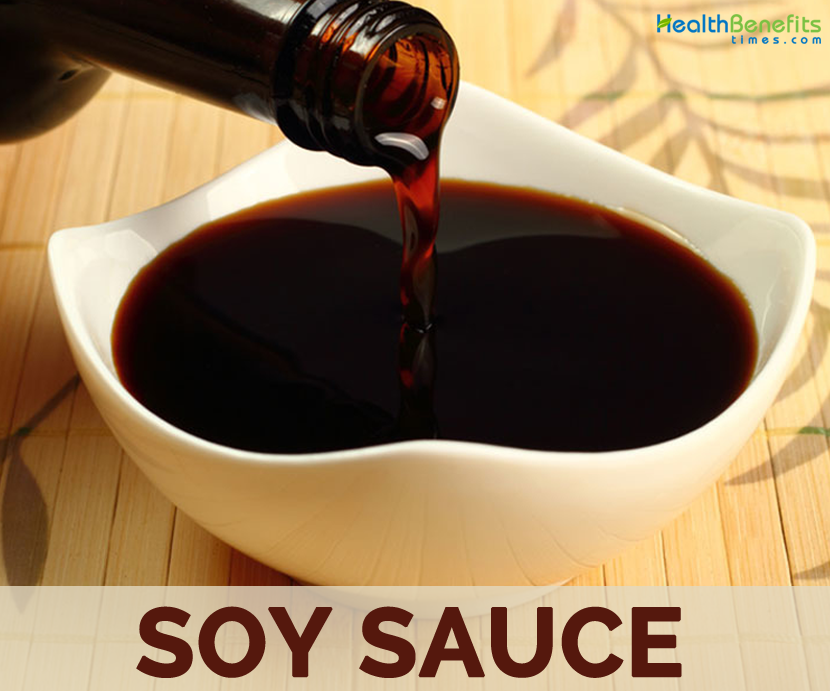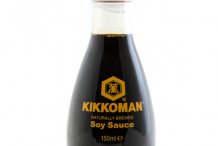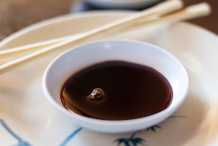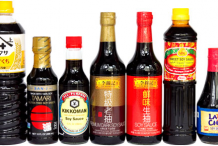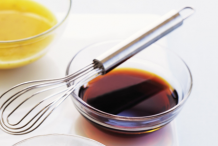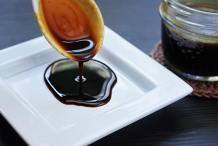| Soy Sauce Quick Facts |
| Name: |
Soy Sauce |
| Origin |
China |
| Colors |
Vary from light amber to darker, brownish-black color |
| Shapes |
Liquid |
| Taste |
Sweet, sour, salty, and bitter |
| Calories |
11 Kcal./cup |
| Major nutrients |
Sodium (67.00%)
Tryptophan (7.50%)
Iron (5.38%)
Isoleucine (5.26%)
Valine (4.45%)
|
| Health benefits |
Reduce cholesterol and LDL cholesterol level, reduce the risk of breast cancer, reduce weight, cure diarrhea |
Soy sauce also called soya sauce in British English is actually a liquid condiment of Chinese origin, made from a fermented paste of soybeans, roasted grain, brine, and Aspergillus oryzae or Aspergillus sojae molds. Soy sauce in its current form was created about 2,200 years ago during the Western Han dynasty of ancient China, and spread throughout East and Southeast Asia where it is used in cooking and as a condiment. Soy sauce is extensively used as an important flavoring and has been combined into the traditional cuisines of many East Asian and Southeast Asian cultures. Despite their rather similar appearance, soy sauces made in different cultures and regions are different in taste, consistency, fragrance and saltiness. Soy sauce retains its quality longer when kept away from direct sunlight. The word “soy” comes from the Japanese word for soy sauce, “shoyu.” In fact, the soybean itself was named from soy sauce.
Soy sauce can be made by two simple methods: the traditional brewing method, or fermentation, and the non-brewed method, or chemical-hydrolyzation. The fermentation method normally takes up to six months to complete and results in a transparent, delicately colored broth with balanced flavor and aroma. The non-brewed sauces take only two days to make and are often opaque with a harsh flavor and chemical aroma. The traditionally prepared soy sauce is a mixture of soybeans and roasted grain which is usually rice, barley or wheat. Today, soy sauce is one of the best-known soy products worldwide. It is a staple ingredient in many Asian countries and used widely across the rest of the world. Soy sauce has been used to enhance the flavor profiles of many types of food, including chicken and beef entrees, soups, pasta, and vegetable entrees.
History
The ancient people of Asia used to preserve meat and fish by packing them in salt. The liquid byproducts that leeched from meat preserved in this way were commonly used as liquid seasonings for other foods. In the sixth century, as Buddhism became more widely practiced, new vegetarian dietary restrictions came into fashion. These restrictions lead to the replacement of meat seasonings with vegetarian alternatives. One such substitute was a salty paste of fermented grains, an early precursor of modern soy sauce. A Japanese Zen priest came across this seasoning while studying in China and brought the idea back to Japan, where he made his own improvements on the recipe. One major change the priest made was to make the paste from a blend of grains, specifically wheat and soy in equal parts. This change provided a mellower flavor which enhanced the taste of other foods without overpowering them.
By the seventeenth century this recipe had evolved into something very similar to the soy sauce we know today. This evolution occurred primarily as a result of efforts by the wife of a warrior of one of Japan’s premier warlords, Toyotomi Hideyori. In 1615 Hideyori’s castle was overrun by rival troops. One of the warrior’s wives, Maki Shige, survived the siege by fleeing the castle to the village of Noda. There she learned the soy brewing process and eventually opened the world’s first commercial soy sauce brewery. News of the tasty sauce soon spread throughout the world, and it has since been used as a flavoring agent to give foods a rich, meaty flavor. Today soy sauce is used throughout the world in cooking and as a condiment.
Types of soy sauce
Soy sauce is made in a variety of Asian countries, and each country (and sometimes regions within those countries) has its own take. But there are a few main types we tend to see in the U.S.
1. Koikuchi

This is the soy sauce most of us are used to. It’s what Kikkoman makes (at least its regular soy sauce) and is what 80 percent of Japanese people use. The word koikuchi means “dark mouth,” and as its name implies, it’s rich in flavor and dark in color.
2. Usukuchi
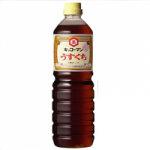
Usukuchi is lighter in color than koikuchi. When you buy light (or lite) soy sauce, you’re generally getting something at least intended to be more like usukuchi. The reason you should be careful assuming this is better for you is because it’s simply not. “Light” in this case simply refers to the color, and in fact, it’s generally saltier. It’s just a regional variation. Usukuchi should be added later in the cooking process to get the full benefit of its flavors.
3. Tamari
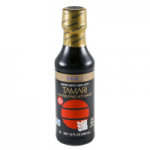
The new en vogue soy sauce, tamari is a thick, viscous soy sauce. While many think it’s an entirely different product, this isn’t the case. It’s another regional variation of soy sauce, made with a fungus called, well, tamari. It has a reputation for being gluten-free, and it is usually at least mostly soybean, though wheat may also be used. Many tamari brands are said to brew without wheat at all. Tamari is most commonly used on sashimi.
4. Genen/teien

These are both names for low-sodium soy sauce, which is koikuchi that has had the salt content reduced (but not eliminated) after brewing.
Other popular varieties
1. Light Soy Sauce (Thin Soy Sauce)

It is used in stir-fry sauces, marinades, soups, and even dipping sauces, light soy sauce is the most common type used in Chinese cooking. It’s what most North Americans would think of as “regular” soy sauce. You can use it whenever a Chinese recipe calls for “soy sauce,” without further clarification. Don’t let the name fool you, though. While light soy sauce is thinner and has a lighter color than dark soy sauce, it is also saltier.
2. Dark Soy Sauce
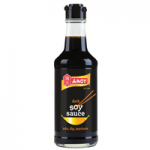
As the name implies, dark soy sauce is darker than light soy sauce. It has a richer, sweeter flavor, thanks to a longer aging period and the addition of caramel and sometimes molasses. Dark soy sauce is used to lend flavor and enhance the color of a dish, for example, in red cooked dishes. You’ll often find it paired with light soy sauce in recipes as well.
3. Mushroom-Flavored Soy Sauce

This is a dark soy sauce that is often infused with dried straw mushrooms. Less frequently you can also find this style made with dried Chinese black mushrooms. Mushroom soy sauce is used in place of dark soy sauce to add an earthy flavor to dishes. Feel free to use it as a substitute in your favorite recipes that call for dark soy sauce. It’s particularly useful in those famous red cooking dishes like this soy sauce chicken with shiitakes. It also makes a nice table condiment.
4. Thick Soy Sauce

Thick soy sauces (also called soy paste or soy jam) are sweeter and have a thicker consistency than dark soy sauce. That is due to the addition of sugar, more wheat in the fermentation process, and, sometimes, a starch thickener used to make it. It takes only a small amount to add flavor to fried rice dishes. If you cannot find thick soy sauce, it’s rather easy to make yourself using light soy sauce.
5. Indonesian Kecap Manis
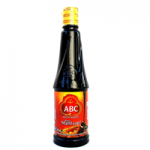
Ubiquitous in Indonesian cooking, Kecap manis is a thick, very sweet soy sauce. It is made with fermented soybeans and a variety of sugar and spices, including palm sugar, star anise, and garlic. Kecap manis is used as a condiment and also in cooking, such as the famous Indonesian fried rice dish nasi goreng. Like that recipe, you’ll find it used often in Dutch cuisine as well because Indonesia was once a Dutch colony.
6. Shrimp-Flavored Soy Sauce
Popular in Eastern China, this style of soy sauce is infused with the brine from dried shrimp (dried prawns). It’s not very common, though you may be able to spot a bottle at your local Asian foods market. You may not find it in many recipes, either. However, it can be used into replace light soy sauce. It seems obvious, but it works particularly well in a seafood Chinese stir-fry. Like the mushroom soy sauce, it’s a good condiment as well.
Traditional uses and benefits of Soy Sauce
- Soy sauce can reduce cholesterol and LDL cholesterol level, if taken in right amount.
- Consumption of soy sauce can help in reducing the risk of breast cancer.
- Soy sauce can help reduce weight.
- Soy sauce is also known to cure diarrhea effectively.
- The consumption of a cup of clear soup containing soy sauce enhances gastric juice secretion in humans.
- Soy sauce possesses antimicrobial activity against bacteria such as Staphylococcus aureus, Shigella flexneri, Vibrio cholera, Salmonella enteritidis, nonpathogenic Escherichia coli and pathogenic E. coli O157:H7.
Culinary Uses
- You can use soya sauce for seasoning as well as sautéing vegetables.
- You can use a combination of soy sauce, ginger and garlic to marinade tempeh, chicken or baked tofu.
- Place a container of soy sauce on your dinner table and use it as the substitute for salt.
https://www.youtube.com/watch?v=kfFnInyB6zs
How Is It Made?
Many different types of soy sauce are available. They can be grouped based on their production methods, regional variations, color and taste differences.
Traditional Production
Traditional soy sauce is made by soaking soybeans in water and roasting and crushing the wheat. Then the soybeans and wheat are mixed with a culturing mold, most commonly Aspergillus, and left for two to three days to develop.
Next, water and salt are added, and the entire mixture is left in a fermenting tank for five to eight months, though some types may age longer. During fermentation, enzymes from the mold act on the soy and wheat proteins, gradually breaking them down into amino acids. Starches are converted to simple sugars, then fermented to lactic acid and alcohol.
After the aging process is complete, the mixture is laid out onto cloth and pressed to release the liquid. This liquid is then pasteurized to kill any bacteria. Finally, it’s bottled. High-quality soy sauce uses only natural fermentation. These varieties are often labeled “naturally brewed.” The ingredients list will usually only contain water, wheat, soy and salt.
Chemical production
Chemical production is a much faster and cheaper method of making soy sauce. This method is known as acid hydrolysis, and it can produce soy sauce in a few days instead of many months. In this process, soybeans are heated to 176°F (80°C) and mixed with hydrochloric acid. This process breaks down the proteins in the soybeans and wheat.
However, the resulting product is less attractive in terms of taste and aroma, since many substances produced during traditional fermentation are missing. Therefore, extra color, flavor and salt are added. Additionally, this process produces some undesirable compounds that are not present in naturally fermented soy sauce, including some carcinogens.
In Japan, soy sauce that is brewed in a purely chemical process is not considered soy sauce and cannot be labeled as such. However, it may be mixed with traditional soy sauce to lower costs. In other countries, chemically produced soy sauce may be sold as-is. This is often the type of soy sauce you’ll find in the small packets given with take-away meals. The label will list “hydrolyzed soy protein” or “hydrolyzed vegetable protein” if it contains chemically produced soy sauce.
Other Facts
- It is the most popular soy-based foodstuff found anywhere in the western world.
- Instead of using salt, some people even prefer to use this sauce instead.
- You can also use it to marinate your favorite meat dish before you start cooking.
- Even though it’s often left out, you should put it away in the refrigerator when you don’t need to use it.
Drawbacks
Health concerns are often raised regarding soy sauce, including its salt content, presence of cancer-causing compounds and specific reactions to components like MSG and amines. Listed below are few of the drawbacks of using soy sauce
High in Sodium
Soy sauce is high in sodium, commonly known as salt, which is an essential nutrient that your body requires to function properly. However, high intakes of sodium are linked to increased blood pressure, especially in salt-sensitive people, and may contribute to the risk of heart disease and other diseases such as stomach cancer.
High in MSG
Monosodium glutamate (MSG) is a flavor enhancer. It’s found naturally in some foods and often used as a food additive. It is a form of glutamic acid, an amino acid that contributes considerably to the umami flavor of foods. Umami is one of the five basic flavors in food, often found in what is called “savory” food. Glutamic acid is produced naturally in soy sauce during fermentation and thought to be a significant contributor to its appealing flavor. Additionally, MSG is often added to chemically produced soy sauce to enhance its flavor.
Contain Cancer-Causing Substances
A group of toxic substances called chloropropanols can be produced during food processing, including the production of soy sauce. One type, known as 3-MCPD, is found in acid-hydrolyzed vegetable protein, which is the type of protein found in chemically produced soy sauce. Animal research has found 3-MCPD to be a toxic substance. It was found to damage the kidneys, decrease fertility and cause tumors. Due to these problems, the European Union set a limit of 0.02 mg of 3-MCPD per kg (2.2 lbs) of soy sauce. In the US, the limit is higher at 1 mg per kg (2.2 lbs.).
Contains Amines
Amines are naturally occurring chemicals found in plants and animals. They are often found in higher concentrations in aged foods, such as meats, fish, cheeses and some condiments. Soy sauce contains significant amounts of amines, including histamine and tyramine. Too much histamine is known to cause toxic effects when eaten in high quantities. Symptoms include headaches, sweating, dizziness, itching, rashes, stomach problems and changes in blood pressure.
Contains Wheat and Gluten
Many people are unaware that soy sauce can contain both wheat and gluten. For people with wheat allergies or celiac disease, this could be problematic.
Research has found that both soy and wheat allergens are completely degraded in the soy sauce fermentation process. That said, if you are not sure how your soy sauce has been produced, you cannot be sure it is free from allergens. The Japanese soy sauce tamari is often regarded as a wheat- and gluten-free soy sauce alternative. While this can be true, some types of tamari may still be made with wheat, though with smaller amounts than are used in other types of soy sauce.
Recipe
General Tso’s Chicken
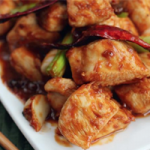
Ingredients
Chicken:
- 1 pound boneless, skinless chicken breast, cut into 1-inch pieces
- Sea salt and freshly ground white pepper
- 1 tablespoon cornstarch
Sweet Sauce:
- 1/2 cup chicken stock
- 1 tablespoon Guilin chili sauce or Sriracha
- 1 tablespoon ketchup
- 1 tablespoon light soy sauce
- 1 tablespoon rice vinegar
- 1 tablespoon yellow bean sauce (soy bean paste)
- 1 teaspoon honey
- 1/2 teaspoon dark soy sauce
Stir-Fry:
- 1 tablespoon vegetable oil
- 1 clove garlic, peeled, left whole and crushed
- 1 tablespoon Shaohsing rice wine or dry sherry
- 4 whole dried Sichuan chilies
- 2 scallions, chopped
- 1 cup peanuts, toasted and chopped
- 8 ounces egg noodles, cooked per package instructions
Instructions
For the chicken:
- In a large bowl, sprinkle the chicken with a pinch of salt and pepper. Add the cornstarch and mix well.
For the sweet sauce:
- In another bowl, add the stock, chili sauce, ketchup, light soy sauce, rice vinegar, yellow bean sauce, honey and dark soy sauce together and set aside.
For the stir-fry:
- Heat a wok over high heat and when the wok starts to smoke, add the vegetable oil. Add the garlic and chicken pieces and let the chicken settle in the wok for 1 minute before stir-frying for another 2 minutes.
- As the chicken starts to turn opaque, add the rice wine and dried chilies and fry for a few seconds.
- Then add the sweet sauce mixture and cook for another 3 minutes.
- Cook the chicken in the sauce until the chicken is cooked through and the sauce has reduced is slightly sticky and has a thicker consistency, another 1 to 2 minutes.
- Stir in the scallions and peanuts and cook for less than 1 minute.
- Toss in the noodles and then transfer to a serving plate.
Comments
comments


